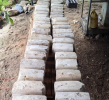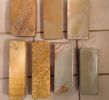OK, let's talk about sharp.
Most folks can get a blade sharp - You can use a rock to do that - What escapes many new makers is the ability to get a blade sharp enough to be "Really Sharp" or "Scary Sharp".
So, here we go:
1) The WIRE - A sharp blade is often hiding behind the edge burr called "THE WIRE". This is especially true on blades worked on belt grinders and one direction sharpeners. The edge gets thinner and thinner until it starts to bend over whenever pressure is applied. To remove this the edge is STROPPED on a leather board charged with a fine compound like green chrome. Five to ten strokes at an angle a bit higher than the blade was sharpened at and the "wire" will pop off, leaving a very sharp edge. Use a fair amount of down pressure when stropping. After stropping, remove any remaining wire by cutting through a piece of card stock or light cardboard a few times. You will feel the knife suddenly become much smoother. I use old postal advertising mailers. If you have a friend who works in a business that sends out advertisements, they may give you a box of hundreds of these left over from a mailing campaign. I cut up an entire 4X6" card into many strips after sharpening every knife. This improves the cutting immensly.
2) Edge and bevel shape - The old saying is "GEOMETRY CUTS" This is a simple statement that escapes most new makers. The shape of the entire cutting surface is part of how sharp the edge gets. They make an edge that is far too thick before sharpening and far too high in angle.
When I was a newer smith, I made a friend a large fillet knife for rockfish. I asked him how it worked. He said, "It worked very well once I put an edge on it." I had sharpened it until I thought it was very sharp. He told me, "Yes, it had an edge on it, but it was way too thick and blunt angled." He took it to his stones and reduced the Thickness Behind the Edge (TBE) and then resharpened it at around 10 degrees per side. It cut many fish before needing to be resharpened after that.
3) Edge smoothness - Looking at the edge with a 10X loupe, or a 30X microscope may show the edge looks like a photo of the Rocky Mountains. Using reducing grits and harder surfaces will slowly wear down the ridges until they are plains. Smooth and even edges are what cuts. Many people use grinders and sandpaper to put on an edge, and that may get it shaped to the right thickness and shape, but you have to remove all those micro-serrations to get it really sharp. This is done either by using water stones, finer belts, and hand sharpening on strops and other surfaces ... and finer and finer compounds and grits. Some folks take this to an extreme degree and end up with 50,000 mesh diamond paste, but for most knives a final grit of around 1000 and a stropping using something equivalent to 8000 (green chrome, white rouge, red rouge, etc.).
If using the belt grinder, use the flat platen, very slow speed, and a fresh belt to sharpen a knife. The slack belt if OK for final sharpening if you like a slight Apple-Seed grind, but for true scary sharp you want a hard and flat surface behind the abrasive. If using papers, place them on a granite surface plate or sheet of glass. If using felt or leather, get the hardest grade you can (Horse Butt leather is the best).
4) Finally, equipment and methods - As I said, a rock will sharpen a knife, but to give i a good long-lasting edge, you have to have some things in place. First, sharpening speed is critical. Let me rephrase that ... sharpening slowness is critical. Using a bench grinder, angle grinder, non VS belt grinder, or other fast-moving system is going to destroy the edge. Maybe not so much that it turns blue, but it will create issues in hardness and stresses that will affect the final outcome. So, slow it down. Variable speed tools slowed down to the lower end is what most folks do. The real purists only use hand sharpening to avoid ruining the edge that they spent so much effort to forge and HT. Same goes for stropping. paper wheels are popular with some folks (not my favorite) but used wrong they can damage the edge more that they improve it. The 3 main rules are simple - Go slow, take your time, and go slow.
Keeping a constant angle and moving the edge across the sharpening surface at an even speed are also professional techniques.
A proper sharpening of a katana is considered a task to only be done by a Togishi with decades of experience by many people. I am not one of those people. If it is a National Treasure, sure, send it to a NBTHK listed professional, but if it is a sword that you or another normal smith made, you can do it yourself. The trick is taking your time. A proper sharpening, be it knife or sword, takes time. A quick edge can be put on in 60 seconds on a VS grinder with a 220 to 400 grit belt by an experienced smith. This is what I do for most kitchen and fishing knives. When I want a really sharp edge, it takes up to 10 minutes an inch.
5) Jigs and Fixtures - We all see lots of special jigs and things to sharpen knives. Most of us have bought several of them. These can run from $50 to well over a thousand dollars ... plus the stones and abrasives needed. They don't have any magic and don't do anything you can't do for less that $100 worth of DMT stones and practice. Most won't hold a candle to a well sharpened knife on water stones. Learn to do it by hand first and the machines will make it easier. Try to let a machine do it before you have spent the time learning to sharpen is just wasting both time and money. If going into the sharpening business, special tools and jigs make for consistency, but as a hobby maker they make you a fool most of the time. Most of the pricey systems - Pro-sharp, Lansky, Wicked Edge, Apex, Tormek, etc. just do a mediocre job. It is the users skill that makes them work. Buy them if you want, but don't expect them to do the work for you.
I suggest a newer smith get of 8" or 10" DMT stones/plates in four grits. Extra-Coarse, Coarse, Fine, and Extra fine. The Duo-Sharp combo stones are the best bang for the buck. Get the base holder for the stones/plates, too. That plus a leather strop and a a stick of green chrome will sharpen knives for the next 20 years. Probably $150-$250 total. They sell the set as a package with the base for a little over $200. (search DMT 10" package. Here is just one hit -
https://www.sharpeningsupplies.com/...aspx?msclkid=db3cafe0d05911ecb5b2b7f9d9dd8030)
Buying expensive waterstones when you are just learning is like buying a Corvette to learn to drive. It will cost you a lot and teach you very little. While waterstones may be the Rolls Royce of sharpening, DMT stones are the Chevvy Trucks.
There is more than this, but if you follow these simple principles you will learn the rest pretty much automatically.


